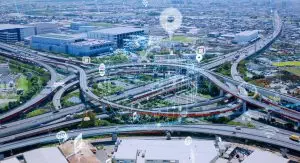The intricate interaction between transportation infrastructure and real estate prices and rents is a crucial factor in urban development, attracting growing attention from economists, urban planners, and policymakers. The strategic positioning of roads, bridges, public transit systems, and other transportation facilities can profoundly impact the economic dynamics of an area. Understanding the nuanced relationships underlying the influence of transportation infrastructure on property values and rental markets is essential for informed decision-making in urban planning and development.
One significant way transportation infrastructure affects real estate prices is through accessibility. Proximity to well-developed transportation networks, such as highways, metro lines, or bus terminals, can enhance a location’s accessibility, making it more appealing for potential residents and businesses. Properties near transportation hubs or well-connected roadways often experience increased demand, leading to higher real estate prices. This demand-driven appreciation is not limited to residential properties; commercial real estate in such areas also tends to increase in value due to improved accessibility for customers and employees.

The development of transportation infrastructure can stimulate urban expansion and rejuvenation. With new roads or transit systems, previously overlooked areas may attract interest from developers and investors. The anticipation of improved connectivity often sparks development activities, including constructing residential complexes, commercial spaces, and amenities. This surge in development, in turn, contributes to rising real estate prices as the overall desirability and vibrancy of the area increase.
The impact of transportation infrastructure on rental markets is equally significant. Rental levels often reflect the convenience and accessibility associated with a location. Areas with efficient transportation options tend to experience higher rental demand, leading to increased rental prices. Additionally, reliable and well-connected transportation can reduce commuting time and costs for residents, making such locations more appealing for tenants and contributing to an increase in rental values.
The relationship between transportation infrastructure and real estate is not always straightforward. Negative externalities, such as noise pollution, traffic congestion, or disruptions during construction, can temporarily lower property values. Balancing the positive and negative impacts requires a nuanced understanding of the local context and careful planning to mitigate potential downsides.
Analyzing the effects of transportation infrastructure on real estate prices and rents requires a multifaceted approach. Data-driven studies, incorporating factors such as proximity to transportation nodes, travel time reductions, and historical property value trends, play a crucial role in understanding complex interactions. Advanced modeling techniques and econometric analyses are used to isolate the specific impact of transportation infrastructure from other variables that may influence real estate dynamics.
The relationship between transportation infrastructure and real estate prices and rents is a critical aspect of urban development that demands careful consideration. The strategic positioning of roads, bridges, and transit systems can be a powerful driver of economic growth, influencing property values and rental markets. As cities continue to evolve, a comprehensive understanding of these dynamics becomes essential for policymakers and urban planners to foster sustainable and inclusive development in the ever-changing urban landscape.
The Significance of Accessibility in Shaping the Interplay Between Transportation Infrastructure and Real Estate
At the core of the complex relationship between transportation infrastructure and real estate lies the crucial element of accessibility. How carefully planned roads, highways, and public transportation systems intersect plays a vital role in determining a location’s accessibility. Areas that benefit from enhanced connectivity often see a noticeable increase in property values and rental rates. Specifically, areas with easy access to major transportation hubs, such as airports or train stations, become focal points of heightened real estate activity.

Proximity to these well-connected transportation nodes is widely seen as a valuable asset, as it helps reduce commuting times and enhances overall convenience for both residents and businesses. Ultimately, the accessibility factor is key to understanding how transportation infrastructure intricately impacts the real estate landscape, significantly influencing the economic and practical considerations of potential property buyers and renters.
The Intersection of Transportation Infrastructure and Real Estate: Successes and Challenges
The relationship between transportation infrastructure and real estate dynamics hinges on accessibility. The careful planning and intersection of roads, highways, and public transportation systems play a pivotal role in shaping the accessibility of a given location, thereby exerting a profound influence on property values and rental rates.
Enhanced connectivity in certain areas often results in a surge in property values and rental rates, driven by the heightened desirability associated with easy and efficient transportation options. Major transportation hubs, including airports and train stations, become focal points of heightened real estate activity, attracting both residential and commercial interests.

The impact of accessibility becomes more pronounced when considering commuting times. Well-connected areas, with thoughtfully designed and efficiently executed transportation infrastructure, offer residents and businesses the advantage of reduced travel times. This reduction in commuting duration translates into increased convenience, positioning such areas as prime locations for potential property buyers and renters.
Businesses also recognize the importance of accessibility for both employees and customers and often seek locations with efficient transportation infrastructure. The ease with which individuals can access a business establishment can significantly impact its success, making well-connected areas more attractive for commercial ventures.
The ease of reaching key destinations becomes a crucial consideration that shapes real estate preferences. As a result, areas with superior accessibility tend to command higher property values and rental rates, reflecting the practical and economic benefits they offer to residents and businesses.
Understanding the intricate interplay between transportation infrastructure and real estate necessitates a thorough examination of the accessibility landscape. Urban planners and policymakers must carefully consider how roads, highways, and public transit systems intersect to create a network that facilitates easy movement within a city or region. Additionally, the role of major transportation hubs cannot be overstated, as they often act as catalysts for increased real estate activity in their vicinity.
The significance of accessibility in shaping the interplay between transportation infrastructure and real estate cannot be overstated. Well-planned and efficiently executed transportation networks enhance the desirability of locations, leading to increased property values and rental rates. As cities continue to evolve, a focus on optimizing accessibility becomes paramount for sustainable and inclusive urban development, ensuring that the benefits of transportation infrastructure are fully realized in the realm of real estate.
Technological Advancements and Future Trends
The ongoing progression of technology is reshaping the transportation infrastructure and its relationship with real estate. Ride-sharing services and intelligent transportation systems are key drivers of this transformation, altering traditional dynamics and property valuation. The shift towards remote work, accelerated by the COVID-19 pandemic, further amplifies the impact. This upheaval not only influences property valuation but also necessitates new considerations for urban planners and real estate developers.

The rise of ride-sharing services, such as Uber and Lyft, has not only changed urban mobility but also impacted residential choices. The convenience of on-demand rides has reduced the importance of proximity to public transportation or personal vehicles, potentially altering real estate values.
Intelligent transportation systems, including smart traffic management and real-time data analytics, are enhancing accessibility, and influencing property values as residents and businesses prioritize locations with efficient transportation solutions.
The widespread adoption of remote work is altering the transportation-real estate equation by reducing the importance of living close to employment centers. This shift challenges traditional urban-centric real estate valuation and demands a reevaluation of property prices.
The integration of emerging technologies, such as autonomous vehicles and sustainable transportation solutions, is poised to introduce further disruptions, altering the demand for certain types of real estate and necessitating a forward-thinking approach to urban planning and development.
The continuous technological revolution in transportation is transforming the complex connection with real estate. Ride-sharing services, intelligent transportation systems, and remote work are now essential components of everyday life, leading to a significant shift in the factors affecting property valuation. It is essential to anticipate the influence of emerging technologies like autonomous vehicles and sustainable transportation solutions to promote resilient and flexible urban development strategies. Embracing innovation becomes crucial for cities aiming to remain at the forefront and harness the intersection of technology and real estate for the improvement of urban living.
In conclusion, evaluating the impact of transportation infrastructure location on real estate prices and rents requires a thorough analysis considering factors such as accessibility, zoning policies, and the evolving interplay of technology and urban development. Well-planned transportation projects can positively influence property values and rental rates, but it’s important to anticipate potential negative effects and address the need for adaptive zoning policies.
The integration of transportation infrastructure planning and urban development strategies is crucial as cities evolve. The collaborative efforts of researchers, policymakers, and urban planners are essential in creating innovative solutions that enhance accessibility and contribute to sustainable, inclusive, and resilient communities.
Achieving a harmonious balance between transportation infrastructure and real estate is an ongoing endeavor that requires foresight, adaptability, and collaborative creativity. Recognizing the interconnectedness of these elements and addressing their evolving dynamics is crucial in shaping urban environments that meet current needs and remain resilient in the face of future changes. As cities evolve, the integration of transportation planning and urban development will continue to be a pivotal focal point, necessitating a holistic and forward-thinking approach to ensure the creation of vibrant, efficient, and sustainable communities for generations to come.







